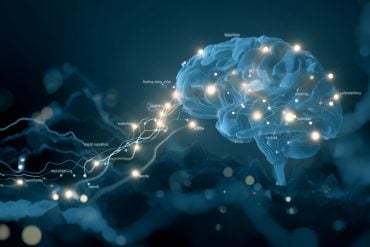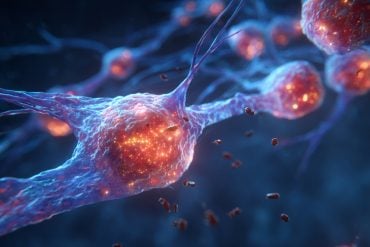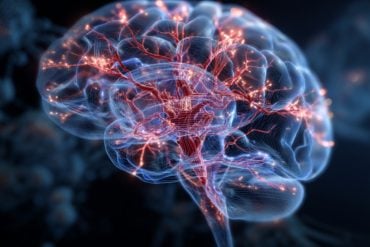Summary: The subthalamic nucleus in the brain communicates with the motor system to help the body stop an action, researchers confirm.
Source: University of Iowa
University of Iowa researchers have confirmed in a new study that a specific region in the brain is critical to governing the mind’s communication with the body’s motor control system.
The findings could yield advances in treatment for Parkinson’s disease, as declining motor coordination is a central symptom of the disorder.
In experiments with humans, the researchers pinpointed the subthalamic nucleus as the region in the brain that communicates with the motor system to help the body stop an action. This communication is vital because it helps humans avoid surprises and react to potentially dangerous or unforeseen circumstances.
The subthalamic nucleus is a tiny grouping of cells that is part of the basal ganglia, which is a key circuit in controlling movement. The basal ganglia takes initial motor commands generated in the brain and either amplify or halt specific parts of those commands as they pass from the central nervous system to the spinal cord.
“You can think of the subthalamic nucleus as the core region in this ‘halting’ of extra, unwanted components of compound movements, as it is the last relay station before the output nuclei of the basal ganglia, which then communicates these commands to the wider motor system,” says Jan Wessel, associate professor in the Department of Psychological and Brain Sciences at Iowa and the corresponding author on the study.
Previous research had indicated the subthalamic nucleus’ role in this stage of brain-motor control communication, but the hypothesis had not been directly tested in humans until now.
To do that, the researchers used some ingenious techniques. First, they recruited 20 patients who have Parkinson’s disease, which affects motor control. These patients had implanted deep-brain stimulators, which the researchers used to activate or deactivate the subthalamic nucleus.
They then tracked those changes to motor-control activity through a simple stop-action task, monitoring the brain-motor control responses through a technique called transcranial magnetic stimulation.
Parkinson’s disease patients are treated regularly with deep-brain stimulation, but the addition of transcranial magnetic stimulation allowed the researchers to confirm the subthalamic nucleus’ definitive role. Wessel partnered on the experiments with Jeremy Greenlee, professor and the Arnold H. Menezes Chair in the Department of Neurosurgery, who cares for patients with Parkinson’s disease.
“Deep-brain stimulation is the only method to causally and systematically influence the activity of deeply embedded brain nuclei like the subthalamic nucleus in awake, behaving humans,” says Wessel, also an associate professor in the Department of Neurology.

“However, combining deep-brain stimulation with transcranial magnetic stimulation is a highly complicated and novel technical endeavor, especially in awake, behaving humans.”
The subthalamic nucleus–motor control link is important, Wessel says, because it puts to rest a central question in the brain’s communication with the body’s motor system, especially how an initiated action is suddenly halted. But it has potential benefits to patients, too.
“The subthalamic nucleus is a key therapeutic target in Parkinson’s disease,” Wessel says.
“Indeed, just like it was done for the patient sample in our study, implantation of stimulation electrodes into the subthalamic nucleus is a highly successful treatment option for the motoric symptoms of Parkinson’s disease. Our study provides some mechanistic insights into this potential patient-care benefit.”
The study, “A causal role for the human subthalamic nucleus in non-selective cortico-motor inhibition,” was published online July 15 in the journal Current Biology.
Contributing authors, all from Iowa, include Darcy Diesburg and Nathan Chalkley.
Funding: The National Institutes of Health and the U.S. National Science Foundation funded the research.
About this neuroscience research news
Author: Richard Lewis
Source: University of Iowa
Contact: Richard Lewis – University of Iowa
Image: The image is in the public domain
Original Research: Open access.
“A causal role for the human subthalamic nucleus in non-selective cortico-motor inhibition” by Jan Wessel et al. Current Biology
Abstract
A causal role for the human subthalamic nucleus in non-selective cortico-motor inhibition
Highlights
- During rapid action stopping, CSE is broadly suppressed
- This is ostensibly due to the non-selective influence of the STN
- We measured CSE via TMS while influencing STN via DBS
- DBS removed the non-selective effect of stopping on CSE, causally linking STN and CSE
Summary
Common cortico-basal ganglia models of motor control suggest a key role for the subthalamic nucleus (STN) in motor inhibition. In particular, when already-initiated actions have to be suddenly stopped, the STN is purportedly recruited via a hyperdirect pathway to net inhibit the cortico-motor system in a broad, non-selective fashion. Indeed, the suppression of cortico-spinal excitability (CSE) during rapid action stopping extends beyond the stopped muscle and affects even task-irrelevant motor representations.
Although such non-selective CSE suppression has long been attributed to the broad inhibitory influence of STN on the motor system, causal evidence for this association is hitherto lacking. Here, 20 Parkinson’s disease patients treated with STN deep-brain stimulation (DBS) and 20 matched healthy controls performed a verbal stop-signal task while CSE was measured from a task-unrelated hand muscle.
DBS allowed a causal manipulation of STN, while CSE was measured using transcranial magnetic stimulation (TMS) over primary motor cortex and concurrent electromyography. In patients OFF-DBS and controls, the CSE of the hand was non-selectively suppressed when the verbal response was successfully stopped. Crucially, this effect disappeared when STN was disrupted via DBS in the patient group.
Using this unique combination of DBS and TMS during human behavior, the current study provides first causal evidence that STN is likely involved in non-selectively suppressing the physiological excitability of the cortico-motor system during action stopping. This confirms a core prediction of long-held cortico-basal ganglia circuit models of movement.
The absence of cortico-motor inhibition during STN-DBS may also provide potential insights into the common side effects of STN-DBS, such as increased impulsivity.







